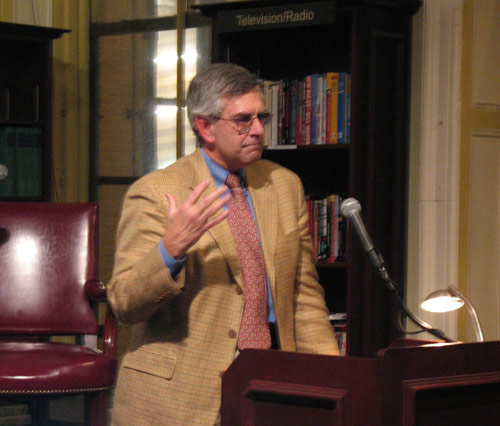Day: November 17th, 2006
Anne-Sophie Mutter at Carnegie Hall
Another Carnegie Hall concert. This time, SYB and I decided to forego the usual pre-concert trip to Burger Joint in favor of something different. After weighing the alternatives, we settled on Pam Real Thai. SYB had never been there — which was a bit surprising since I’ve eaten there about half a dozen times in the last few months — so he was looking forward to making the Thai taste comparison. We arrived just before the dinner rush, and quickly decided upon Fried Tofu, Steamed Chive Dumplings and the Pad Key Mao (stir-fried flat noodle with beef, chili, basil and garlic, which we decided would be our baseline of comparison.) And of course, our flame-quenching Thai iced tea and coffee.
The noodles were far less incendiary than those we had on our other outings, probably because we did not specifically request “Thai spicy.” I have to admit that I did miss the heat, just a little bit.
As usual, a solid meal otherwise. Interestingly, in all the times I’ve been to Pam’s, I’ve never once ordered dessert. Maybe one day. Durian with rice pudding, anyone?



So we were back at Carnegie Hall for the second of German violinist Anne-Sophie Mutter‘s three all-Mozart programs. In honor of Wolfgang Amadeus Mozart’s 250th birthday, Mutter launched Das Mutter Mozart Projekt — an ambitious series of four new Deutsche Grammophon CDs containing all of Mozart’s major compositions for violin. To complement and promote the recordings, Mutter and her accompanist Lambert Orkis have been performing Mozart recitals all over Asia and Europe. This month, they conclude their tour in the United States, with concerts in St. Paul, Chicago, Boston, New York and Washington, D.C.
Tonight, Mutter was performing a set of five Mozart violin sonatas: the C Major, K. 296; the F Major, K. 377; the D Major, K. 306; the E-flat Major, K. 302; and the A Major, K. 526.
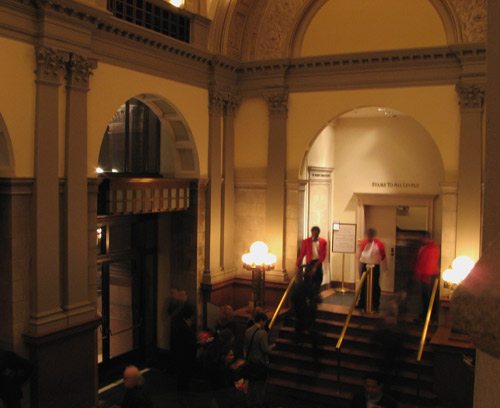

Mutter’s playing was dependably pretty (The New York Times quibbled: at times, too pretty, at the expense of texture and nuance) and technically prodigious. Mutter is known among classical musicians as something of a diva. She lends an undeniable star power to any concert, and few soloists attack their Strads the way she does. She’s a dynamic — and let’s face it: strikingly beautiful — performer. 2006 also marks the 30th anniversary of her debut at the Lucerne Festival, where she was discovered as a 13 year old. A year later, she appeared as a soloist at the Salzburg Whitsun Festival under the baton of flamboyant conductor Herbert von Karajan. The German popular press has covered her avidly ever since: through her marriage, while in her twenties, to Detlef Wunderlich, von Karajan’s lawyer and tax adviser who was then more than twice her age; after Wunderlich’s death from cancer in 1995, her second marriage to the oft-wed, also much senior pianist, conductor and composer Sir André Previn in 2002; their subsequent divorce in August of this year. (The former couple continues to collaborate professionally.)
In addition, there has been occasional grumbling over Mutter’s seemingly out-of control salary demands; it’s reported that she earns over $3 million performing sixty dates a year. For two seasons in the early 1990s, Mutter was effectively blacklisted from performing in London for refusing to cut her standard £10,000 performance rate. She eventually discounted her price, earning herself back in the London Symphony Orchestra‘s good graces. A good investment: the LSO booked her Mozart Project sonata cycle, and is paying the star a budget-busting £30,000 for each of three concerts. Compare that to the £25,000 per year earned by the second violinist of Hallé, Britain’s longest-established symphony orchestra, after fifteen years tenure. Do celebrated soloists have a moral obligation to subsidize their fees to assist financially struggling institutions?
Our seats this night were not quite second row center, but rather second to last row. Still on the parquet, though, and for $10, no complaints. And Mutter came out for one encore, before taking her final bow.
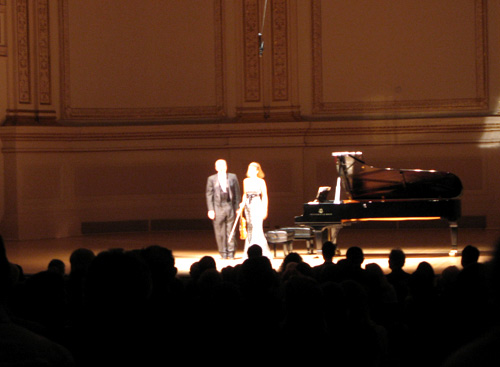
Infinite Jest, most excellent fancy
In cooperation with the National Book Critics Circle, Housing Works Used Book Café in SoHo was hosting Jest Fest 2006: an event to celebrate the 10th anniversary of David Foster Wallace‘s postmodern behemoth of a novel, Infinite Jest.
Wallace’s debut novel, The Broom of the System (1987) and his story collection, Girl With Curious Hair (1989) earned him one of those “Young Writers to Watch” reputations. His much anticipated follow-up arrived on the literary scene in 1996 to a hurricane of hype, and almost universally lauding reviews. Harper’s Bazaar hailed Infinite Jest a worthy contender for the next Great American Novel; Newsday’s Dan Cryer raved, “This book teems with so much life and death, so much hilarity and pain, so much gusto in the face of despair that one cheers for the future of our literature.” The often harsh Michiko Kakutani of the New York Times called Wallace “one of the big talents of his generation, a writer of virtuosic talents who can seemingly do anything.” The book was called “truly remarkable” (Newsweek), “spectacularly good” (New York Magazine) and “brilliant.” (San Francisco Chronicle.)
A stunning accomplishment for a writer then not yet 35 years old, for a supremely ambitious second novel–1,079 pages, including 90 pages of esoteric endnotes–that defies easy categorization or synopsizing. The subject matter ranges from drugs, tennis and political coups; a rambling cast of characters includes a filmmaker, government operatives, politicians, spies, tennis prodigies, suicidal drug addicts, their friends and lovers and the prettiest girl of all time (“PGOAT” – in signature Wallace parlance.) The near-future setting is a fascist state, dubbed the Organization of North American Nations (ONAN)–which the United States forced Canada and Mexico to join–where even the calendar years are auctioned off for corporate sponsorship, to droll effect. To wit: the Year of Glad and the Year of the Depend Adult Undergarment (YDAU.)
Tonight was billed as an evening of discussion and readings by both people involved with the book and fans of IJ. Sadly, Wallace himself, who is notoriously publicity-shy, did not participate.
Wallace’s editors were there, reading brief excerpts from the book, and sharing anecdotes about the man, and the unique challenges to editing and marketing his work. (No doubt! Dare I mention again: 1,079 pages? ):
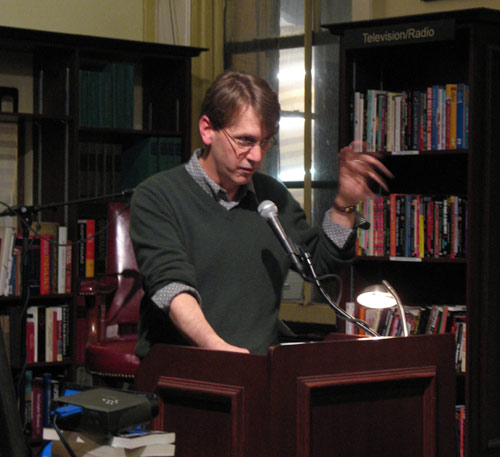
Lev Grossman, author and book critic/technology writer for Time, discussing the novel’s impact with Laura Miller, Salon editor and sometime New York Times book critic, who interviewed Wallace in March 1996.
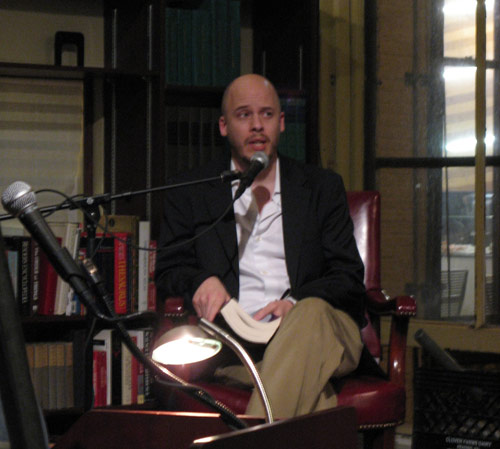
The screenwriter, currently adapting Infinite Jest for film, read the excerpt: “TENNIS AND THE FERAL PRODIGY”, NARRATED BY HAL INCANDENZA, AN 11.5-MINUTE DIGITAL ENTERTAINMENT CARTRIDGE DIRECTED, RECORDED, EDITED, AND–ACCORDING TO THE ENTRY FORM–WRITTEN BY MARIO INCANDENZA, IN RECEIPT OF NEW-NEW-ENGLAND REGIONAL HONORABLE MENTION IN INTERLACE TELENTERTAINMENT’S ANNUAL “NEW EYES, NEW VOICES” YOUNG FILMMAKERS’ CONTEST, APRIL IN THE YEAR OF THE YUSHITYU 2007 MIMETIC-RESOLUTION-CARTRIDGE-VIEW-MOTHERBOARD-EASY-TO- INSTALL UPGRADE FOR INFERNATRON / INTERLACE TP SYSTEMS FOR HOME, OFFICE OR MOBILE (SIC), ALMOST EXACTLY THREE YEARS AFTER DR. JAMES O. INCANDENZA PASSED FROM THIS LIFE.
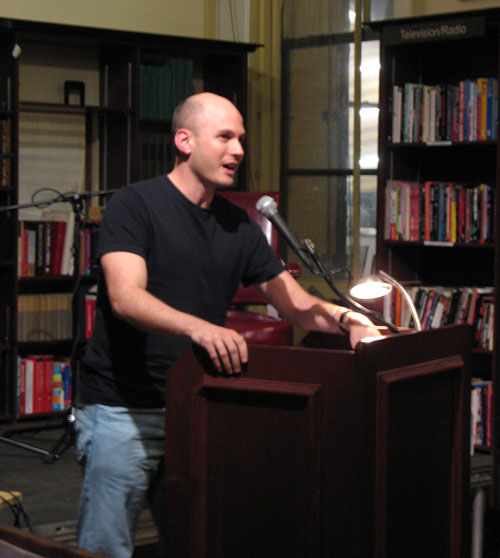
Todd Hanson, head writer for The Onion, with his former co-editor (and ex-girlfriend) Carol Kolb. The pair staged a reading of the Onion piece from 2003: “Girlfriend Stops Reading David Foster Wallace Breakup Letter At Page 20.” The bit struck me as typical of a lot of Onion pieces (and SNL sketches): hinged on a single, sometimes funny, premise — DFW writes really long books! — followed by an ever slightly too long piece that spends the majority of the space reiterating that same joke, to diminishing effect. In this case, bonus points for wink-wink erudite jokiness, only amusing to those few familiar with Wallace’s writing style. (I can’t imagine a more receptive audience on that score.) Sprawling, half-page sentences? Check! Liberal use of acronyms? Check! Endless footnotes? Check! By the time Hanson reached the point in the faux-letter describing the chemical make-up of crystal meth (no, seriously), the audience had had enough.
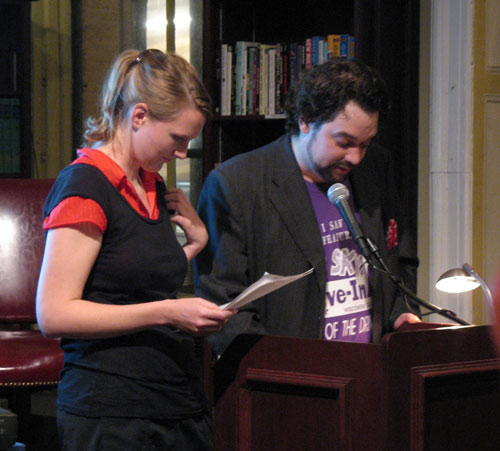
And the biggest draw of the evening: John Krasinski, who plays Jim Halpert on NBC’s The Office. Krasinski is currently working on the film adaptation of Wallace’s 1999 collection of short stories, Brief Interviews With Hideous Men–writing, directing, and possibly starring in a small role. He animatedly read the story, “Victory for the Forces of Democratic Freedom”–which was bizarre, funny, intense and dark all at once… a description befitting of a lot of Wallace’s writings.
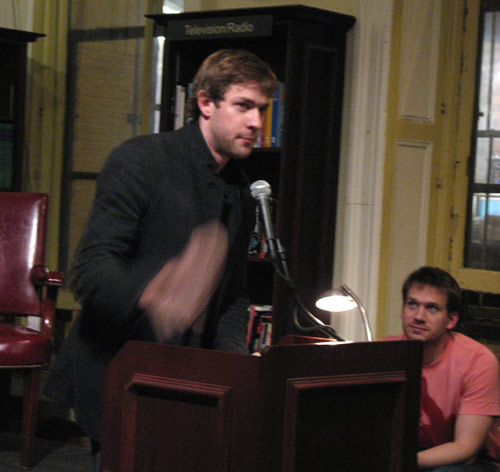
Krasinski lingered around after the event, charmingly chatting up the gaggle of (predominantly female) fans that descended on him after the final word was read. Ooh, isn’t he dreamy?
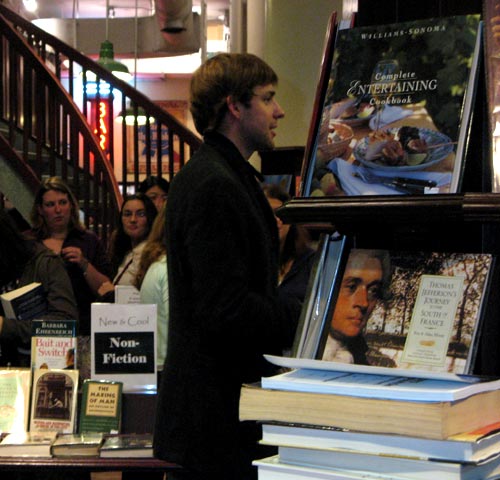
Search
Popular Tags
Categories
Archive
- July 2010
- July 2009
- January 2009
- November 2008
- September 2008
- August 2008
- July 2008
- June 2008
- May 2008
- April 2008
- March 2008
- February 2008
- January 2008
- December 2007
- November 2007
- October 2007
- September 2007
- August 2007
- July 2007
- June 2007
- May 2007
- April 2007
- March 2007
- February 2007
- January 2007
- December 2006
- November 2006
- October 2006
- September 2006
- August 2006
- July 2006
- June 2006
